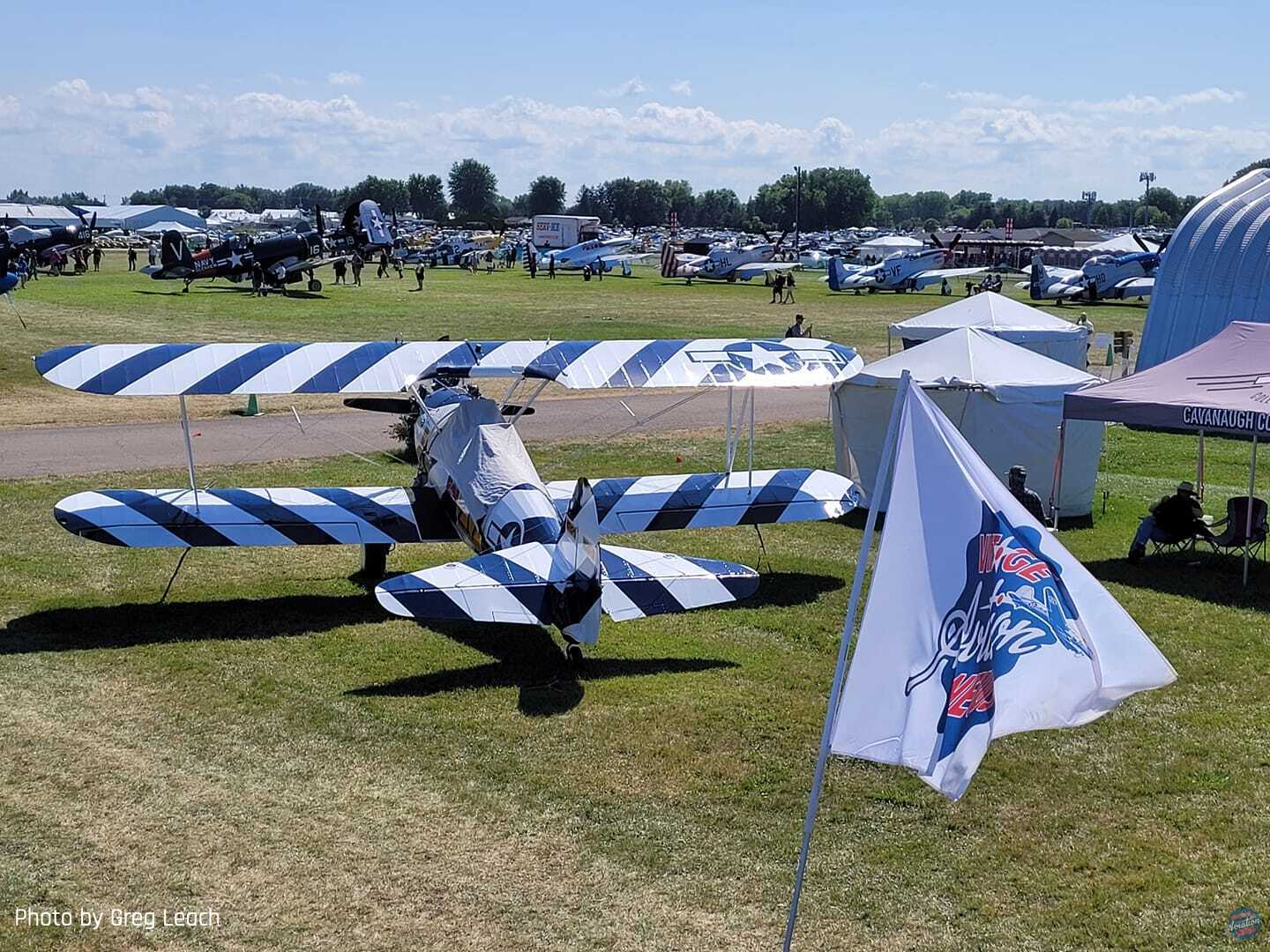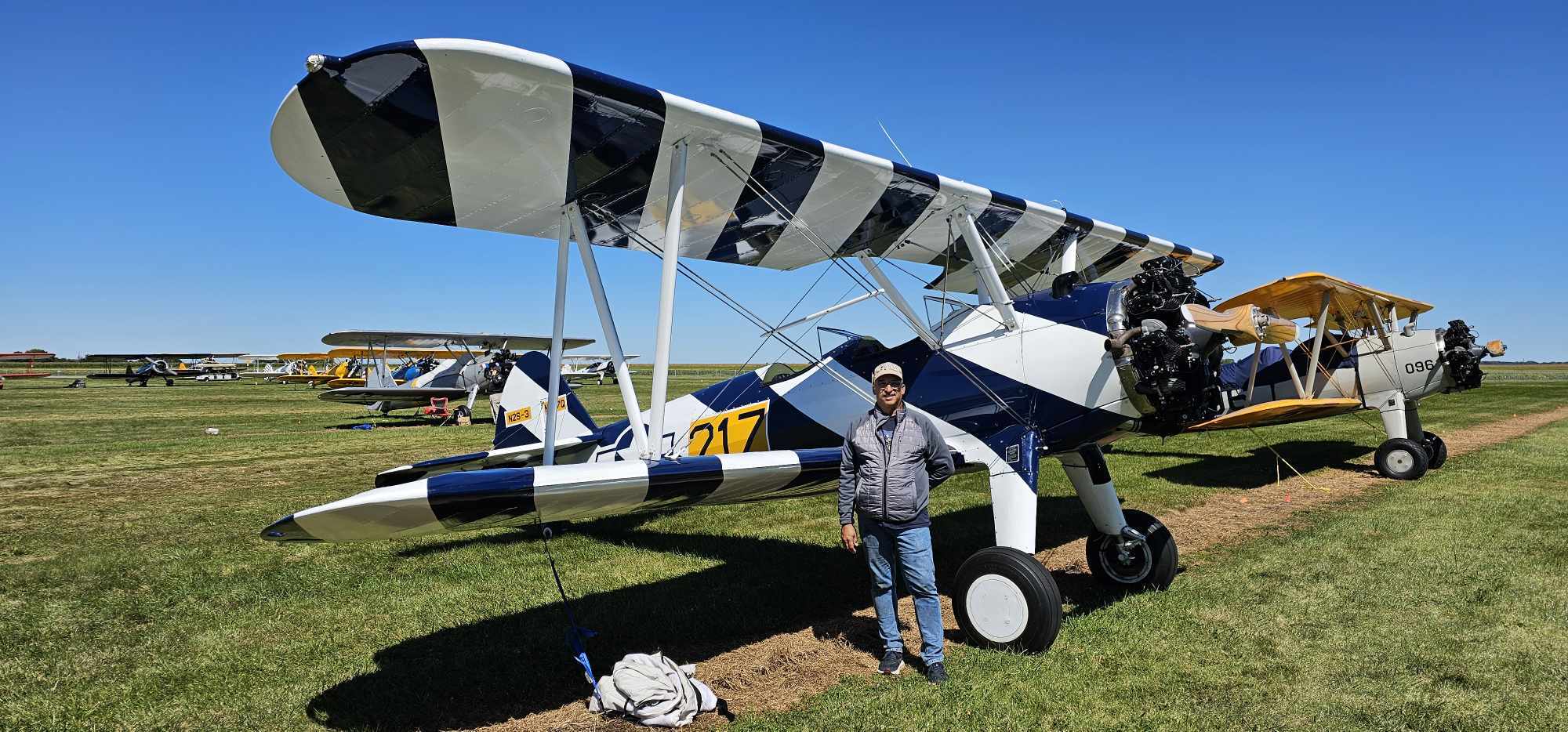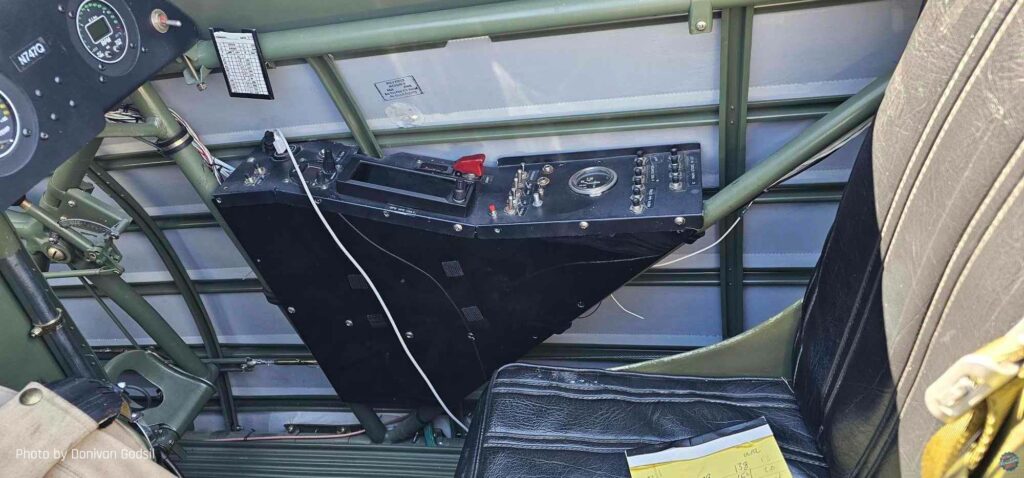At an airshow such as the EAA Airventure in Oshkosh, Wisconsin, there will always be at least one example somewhere on the field of a Boeing-Stearman Model 75, be it in Army, Navy, or civilian colors. But at this year’s event, many heads turned in the warbird section to a Stearman with distinctive blue and white stripes all over the aircraft.

This Stearman was manufactured as construction number 75-4018 at the Boeing-Stearman factory in Wichita, Kansas as part of a batch of Stearmans destined for the British Commonwealth Air Training Plan, where they would be used for flight training in Canada. These aircraft, for administrative purposes, were designated as PT-27 Kaydets, though they differed only from the PT-17 in that they were equipped with enclosed cockpits and cold weather equipment for winter training. The aircraft was delivered to the Royal Canadian Air Force (RCAF) as serial number FJ968 and taken on strength on June 30, 1942. However, the batch of PT-27s that included FJ968 arrived in Canada without proper winter equipment, namely the canopies, so it was stricken from the RCAF and transferred back to the United States Army Air Force (USAAF) and reverted back to its USAAF serial number 42-15829. For the rest of the war, the aircraft was flown at several training bases across the United States, such as Jackson Army Airfield in Mississippi, Terrell Field, Texas, Memphis, Tennessee, and Hicks Field, Texas to instruct countless pilot cadets through primary training. When the war was over, ‘829 was one of thousands of surplus Stearmans stricken from the USAAF’s inventory and registered as N50576.

After going through several owners, a new registration number (N747Q), and two accidents (a fatal one in El Centro, California in 1966, and a second one in Stroudsburg, Pennsylvania in 1977), the aircraft was acquired by the current owner, Tom Torchia, in May 2012. Torchia stated that he bought the airplane because he wanted an airworthy aircraft that would be in need of restoration. However, the fact that the aircraft was still airworthy meant that Torchia was in no hurry to get it restored immediately. Torchia would fly the Stearman, then placed in a white scheme with red trim from Seattle, Washington to the east coast before participating in the 2012 Antique Aircraft Association Fly-In in Blakesburg, Iowa, and the National Stearman Fly-In in Galesburg, Illinois before flying home to Seattle. Eventually, Torchia would move to Arizona, and take Four Seven Quebec with him to Marana Regional Airport (KAVQ), all the while continuing his cross-country flights. As Torchia put it, “I was having way too much fun flying it to take it down for restoration.”

But while on a practice flight for upcoming aerobatic competition in January 2021, “something changed in the sound of the engine. When I was abeam with the numbers at my home airport, I pulled the power for approach to landing and the engine got really quiet. The landing was uneventful, and the engine was running enough to taxi in. After troubleshooting the engine, I determined it was time for an overhaul and pulled the engine off the airplane and sent it to Radial Engines Ltd in Guthrie, Oklahoma. At this point, I proceeded to cut the fabric off the airframe and start the restoration.”

Over the next three years, Torchia went through every component on the aircraft. The fuselage frame and other structural parts were then repainted with a two-part epoxy paint, and specialized metal parts being CAD plated. While restoring the aircraft, Torchia was not alone in his hangar. Two of his friends at Marana, Annemarie Ward and Jim Pyne helped Torchia make approximately 2,000 stitches to sew the fabric onto the wooden wing structure. As the weather in Marana got too hot for Torchia to continue applying fabric, the Continental R-670 radial engine arrived back from Guthrie, and Torchia hung the engine back on the airframe.

As the time for painting the fabric drew nearer, Torchia began thinking about what scheme he wanted to apply to the Stearman. Ultimately, he selected the scheme of a “Recall” airplane. During World War II, most primary training aircraft lacked radio equipment, and thus the armed forces needed a way to communicate with airborne cadets if they needed to return to base as the result of an emergency, such as the approach of inclement weather. The solution was to paint a selected aircraft in a distinctive striped pattern, often of blue and white stripes, with the national roundels painted on opposite sides of most other aircraft. By taking off and flying within visual range of the trainers, the “recall” aircraft would let the others know they had to return to their airfield immediately. While not completely unheard of among the warbird community, the paint scheme would be rare enough to attract the attention of fellow enthusiasts, and with many “recall” aircraft being flown by the Navy, the Stearman’s tail code would be repainted as an N2S-3. While stripping paint from the Stearman’s aluminum panels, he found the number 217 still etched on one of the panels and decided to reproduce that number in the final paint scheme. Despite our team’s best efforts to locate photos of Recall Stearman in service, we were only able to find the two shown below.
On the day where Torchia reassembled the Stearman, he got the help of Jim Pyne, Mel Jordan, and Ken Mahaffey, with the owner of Skydive Marana, Pat Nikitenko, allowing Torchia to borrow his forklift to make the job of installing the top wings and the top wing center section that holds the main fuel tank. After that, the rigging of the aircraft’s flying wires and struts could begin. “The process for rigging is pretty straightforward,” Torchia recounts. “It’s done with plumb bobs, levels and a tape measure. The tolerances for rigging is +/-1/16th of an inch.”

In April 2024, two major milestones were in store for the Stearman. On April 15, the completed aircraft finally rolled out of Torchia’s hangar and on April 24, Tom took N747Q back into the air for the first time in three years! This achievement had a lot of people and organizations to thank for arriving at this momentous point. In addition to those already mentioned, Tom received spare parts from Dusters & Sprayers Supply Inc. (now part of Aircorps Aviation’s Aircorps Depot) and was greatly helped by the members of the Stearman Restoration Association, who provided a wealth of knowledge to go off on.

With the restoration of the Recall Stearman complete, Tom took his prized airplane from Marana to Oshkosh via stops in New Mexico, Texas, Oklahoma, Kansas, Missouri, and Illinois before reaching Wisconsin. During the show, numerous attendees visited Torchia and his Stearman, and for his restoration efforts, Tom Torchia received the Warbird Judge’s Choice Award in the PT-17 Category! Now that he has won a Lindy, we can expect Tom to have even more fun flying his Stearman across the United States, perhaps at an airshow near you! If you would like to hear more from Tom himself, our very own Moreno Aguiari sat down for an interview with Tom, whose Stearman was tied down just outside our camp at Oshkosh. We will soon be uploading this interview to our YouTube channel, so watch this space!




























